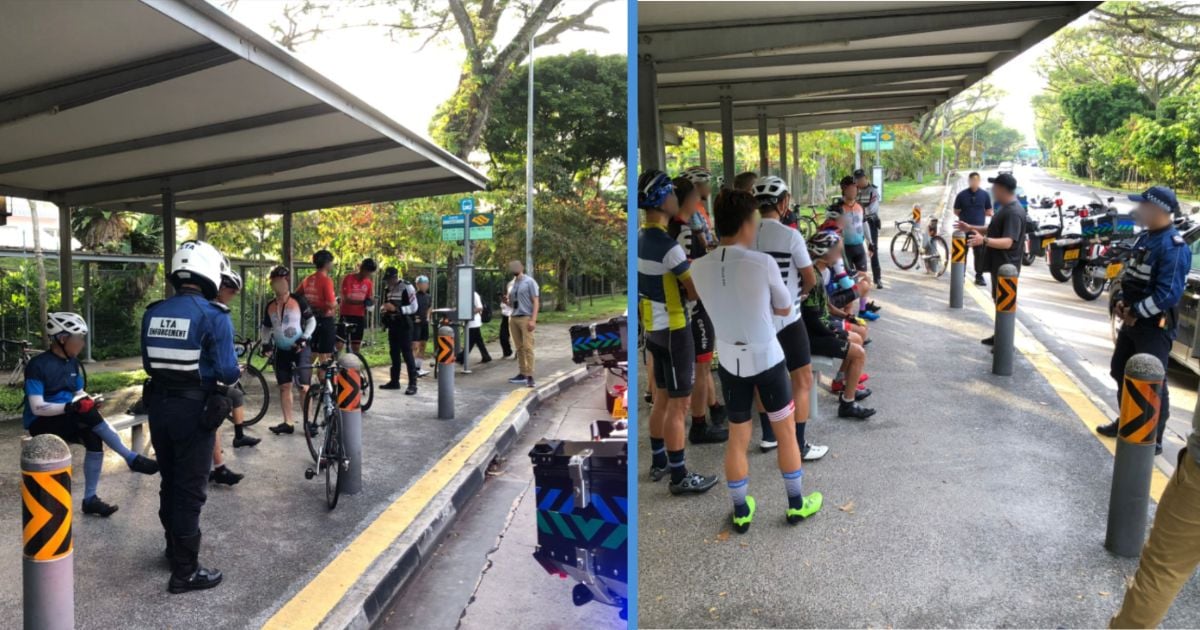Singapore’s drivers and cyclists don’t usually share a very good relationship, with the former claiming cyclists cycle “anyhow” and the latter claiming drivers are being unreasonable.
In a country with smaller roads due to space constraints, it’s understandable why these two groups often clash, and drivers have been complaining that the authorities are not addressing this problem.
However, it seems the authorities have finally stepped in to manage the situation that is getting out of hand.
Reader: It’s about time.
22 Cyclists Caught For Riding-Related Offences In Two Weeks
In a statement on 6 May, the Land Transport Authority (LTA) said that it had carried out joint operations with the Traffic Police (TP) over the last two weeks.
This was done in an attempt to enforce against errant cyclists on roads and non-compliant active mobility devices.
The joint operation saw 22 cyclists being caught for offences such as riding in a group size larger than 10 and riding non-compliant devices.

“LTA will continue to enforce against errant active mobility users who endanger others with their irresponsible behaviour,” the statement said.
The authority added that all active mobility device users must adhere to road traffic and active mobility rules at all times.
Observe Group Length Limit
LTA and TP would like to remind cyclists that they should ensure they observe the group length limit.
This refers to riding in single file in a group of five cyclists or less.
For groups of 10 cyclists or less, they can ride next to each other (i.e. two abreast) and must maintain a minimum distance of 30m, or two lamp posts, between groups on the roads.
It was previously mentioned by LTA and TP that road cyclists who flout the rule on group size can be subjected to a $150 fine.
This fine is also issued to cyclists who run the red light, ride on expressways, or ride abreast of another cyclist along single-lane roads and bus lanes during bus lane operational hours.
LTA and the TP would also like to remind cyclists to ensure that their devices comply with existing requirements.
Manual Bicycles and Three-wheeled Pedal Cycles
For manual bicycles and three-wheeled pedal cycles to be used on the road, they must meet the following requirements:
- Maximum width of 130cm
- Maximum length of 260cm
- At least one functioning handbrake must be installed at the handlebar of the device
Manual Recumbents
For manual recumbents to be used on the road, they must meet the following requirements:
- Maximum width of 130cm
- Maximum length of 260cm
- At least one functioning brake operated by the rider’s hand(s) or feet
- A bright-coloured flag on a pole of a reasonable height
Motorised Personal Mobility Devices and E-Scooters
For motorised personal mobility devices and e-scooters to be used on the road, they must meet the following requirements:
- Maximum weight of 20kg
- Maximum width of 70cm
- Maximum motorised device speed of 25km/h
- Certified to the UL2272 device safety standard
- Existing e-scooters registered before April 2020 (which have been declared to be compliant with the device criteria of weight, width, speed and UL2272 certification), would have undergone a verification inspection
- Before purchasing a new e-scooter, check with the retailer that it has been registered with LTA
- Registered e-scooters should have a unique registration number and an LTA-issued registration mark displayed on the e-scooter. The registration mark should be affixed intact at the front or at the sides of your e-scooter stem, and must be upright, intact, unobscured, and not void/damaged
Power Assisted Bicycles
For power assisted bicycles (PAB) to be used on the road, they must meet the following requirements:
- Maximum weight of 20kg
- Maximum width of 130cm
- Maximum length of 260cm
- Type-approved, sealed and registered at an LTA-Authorised Inspection Centre, and that it bears a registration plate on the rear of the PAB
- Comply with European Standard, EN15194
- Motor power of the PAB must be progressively reduced and finally cut off as the bicycle reaches 25km/h, or sooner, if the cyclist stops pedalling
- View the list of technical requirements of PAB
- PAB rider must be 16 years old or older
- PAB rider must not carry a passenger under 16 years old on a PAB
- PAB rider will have to pass the mandatory theory test for PAB on Singapore Polytechnic’s Professional & Adult Continuing Education Academy (PACE)’s website
Personal Mobility Aids
For personal mobility aids (mobility scooters and motorised wheelchairs) to be used on the road, the following requirements must be met:
- Maximum motorised device speed of 10km/h
- A mobility scooter must satisfy the following:
- Has 3 or more wheels and a footboard
- Is steered by handlebars or delta tiller
- Has only one seat (i.e. devices with multiple seats are not considered mobility scooters)
- Is designed to carry only one individual who is unable to walk or has difficulties walking
- Is propelled by a motor that forms part of the vehicle.
Note that these requirements are only for active mobility devices to be used on roads and that there may be different requirements for devices that can be used on walking and cycling paths. You can view the requirements, and other rules and guidelines, here.



